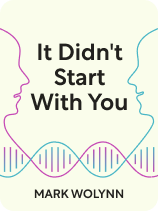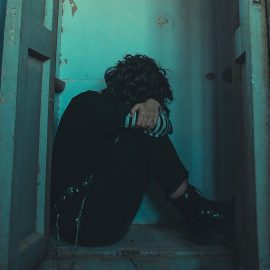

This article is an excerpt from the Shortform book guide to "It Didn't Start With You" by Mark Wolynn. Shortform has the world's best summaries and analyses of books you should be reading.
Like this article? Sign up for a free trial here .
What is Mark Wolynn’s book It Didn’t Start With You about? What is the key message to take away from the book?
It Didn’t Start With You by Mark Wolynn is an exploration of the trauma you could develop from your family during childhood. He links psychology and biology to explain how generational trauma develops and presents his language-based approach to uncovering and healing inherited trauma.
Here’s a brief overview of It Didn’t Start With You by Mark Wolynn.
It Didn’t Start With You by Mark Wolynn
Do you suffer from persistent anxiety, depression, or illness? If you’ve tried and failed to get relief through talk therapy, medication, and lifestyle changes, you may need another approach. The source of your suffering may lie hidden in your unconscious, where traumas from your past—and your family’s past—are stopping you from achieving happiness, success, and freedom.
In his book It Didn’t Start With You, Mark Wolynn, director of The Family Constellation Institute, shares the latest research to reveal how traumas get passed biologically from one generation to the next. These traumas can predispose you to emotional and physical distress.
Does that mean you’re doomed if you’ve inherited trauma? No. The secret to uncovering and resolving these traumas, Wolynn says, is language-based therapy—answering a series of personal questions and following the clues that surface in your responses. When past trauma plays out in our lives, it leaves a trail of clues back to the original source of trauma. These clues include words and phrases that seem particularly emotional or out of context.
In It Didn’t Start With You, Wolynn covers three main topics:
- The roots of our suffering and trauma
- A language-based approach to uncovering hidden trauma
- How to heal trauma and move beyond it
The Roots of Our Suffering and Trauma
In It Didn’t Start With You, Wolynn cites scientific research to support his assertion that prolonged, deep-seated suffering gets passed from generation to generation. In this section, we’ll first examine research confirming that biological markers for trauma get imprinted on our bodies and can transfer across generations. Then we’ll look at the four primary relationship dynamics that Wolynn asserts lie behind prolonged distress.
How Science Says We Inherit Trauma
Cellular biologists have demonstrated that environmental influences—including our mother’s behaviors, thoughts, and beliefs—shape us physically and emotionally from the moment of conception. These influences biologically program us to respond to our environment in certain ways, validating the logic behind Wolynn’s therapeutic approach. Let’s dig into the process more deeply.
Just as our mother’s blood nourishes us with oxygen and nutrients while we’re in the womb, she constantly shuttles us with hormones and signals generated by her emotions. As Wolynn explains, these hormones and signals shape the chemistry and function of our cells. The cells, in turn, influence which genes get switched on.
Scientists can now identify specific genes that are linked with particular emotional states, such as heightened depression and anxiety. So, Wolynn says, we know that which genes get activated determines how we respond to stressors. If your mother experiences high, sustained stress during pregnancy, those stress hormones get passed along, which causes the same stress pattern in you. This could be a good thing—for example, if it prepares you to adapt and survive in a dangerous environment, like a high-crime neighborhood. Alternatively, it could be maladaptive. You could enter the world on high alert and overly sensitive, even when you’re surrounded by love, support, and safety, putting you out of sync with reality.
A Language-Based Therapeutic Approach to Trauma
Wolynn asserts that how we talk about the things that cause us emotional or physical pain can lead us to the source of our trauma. A large chunk of his book It Didn’t Start With You is Wolynn’s therapeutic approach involves asking people a series of questions and listening closely to their answers. Words and phrases that seem particularly impassioned, peculiar, or misplaced serve as beacons indicating that some trauma lies hidden below their awareness. Sometimes investigating our direct life experiences can reveal the source of the trauma, but other times we must trace the source back to prior generations. Wolynn argues that his therapeutic approach can produce results where traditional talk therapy and medication cannot.
The Logic Behind Language-Based Trauma Therapy
Wolynn explains that traumatic experiences compromise our ability to recall and process memories, which keeps us captive to their effects. Here’s why this happens: Some trauma is too difficult for us to process, like an unexpected death in the family, a miscarriage, or being in a war zone. When the trauma hits, our bodies go into survival mode. This causes our minds to go blank—not just at the moment but also later when we try to describe what happened. We just can’t find our words.
Bessel van der Kolk, a Dutch psychiatrist and author of The Body Keeps the Score, has done extensive research showing that trauma blunts the parts of our brain that control speech and allow us to stay present at the moment. This diminishes our ability to accurately recall what happened.
But, Wolynn explains, traumatic memories don’t vanish. They get stored—in our bodies and our unconscious. Then, when anything even remotely similar to the trauma occurs, we often experience the same panic and distress as during the initial incident. This can influence our lives in unexpected ways. Maybe last year you were mugged while you were leaving work. Now you break out into a cold sweat near the end of every workday, you can’t bring yourself to go anywhere new unless someone goes with you, and you flinch when your partner reaches for you. Once we can name the trauma and capture our experience and feelings in words, we can begin to loosen its grip. Until then, Wolynn says, healing will be elusive—focused only on managing symptoms rather than healing the pain at its source.
How to Heal Trauma and Move Beyond It
The last section of the It Didn’t Start With You book is learning how you can heal your wounds to achieve a new level of freedom and joy.
No matter what traumas lie in your past, Wolynn affirms that you can break the pattern of suffering. Sometimes, simply making a link to traumas that happened in your family history can alleviate your most intense symptoms. But usually, a one-time breakthrough is not enough.
To achieve true, sustained healing, you must develop practices tailored to your unique circumstances that bring forward soothing emotions and physical sensations. The practices you choose, Wolynn says, should move you at a deep emotional level—powerful enough to eclipse the old, restrictive emotions and patterns that have been interfering with your freedom. Whichever rituals or practices you choose, you must repeat them regularly to cement your insights and healing.
Wolynn suggests three practices separated into three categories: visualizations, mending broken relationships, and other action-oriented techniques.
How Science Validates Healing Through Images and Rituals
Researchers have confirmed Wolynn’s claim that visualizations and positive experiences—real or imagined—can serve as potent healing tools.
So, Wolynn says, performing healing practices with intention and consistency—and allowing ourselves to be emotionally moved in the process—reprograms our bodies. We replace old, painful images, feelings, and memories with new, positive memories and emotions. Then, when old, unhealthy patterns start to surface, we’ll have a totally new internal reference point—one that will guide us to respond with love, care, and compassion. For example, instead of reacting in anger or shutting down when your mother criticizes you, you will receive her words with grace and true appreciation—knowing that she is loving you in the way she knows.

———End of Preview———
Like what you just read? Read the rest of the world's best book summary and analysis of Mark Wolynn's "It Didn't Start With You" at Shortform .
Here's what you'll find in our full It Didn't Start With You summary :
- A look into the causes of persistent anxiety, depression, and illness
- How the traumas of your past are stopping you from being truly happy and free
- How to resolve deeply-rooted trauma by applying a unique therapeutic approach






